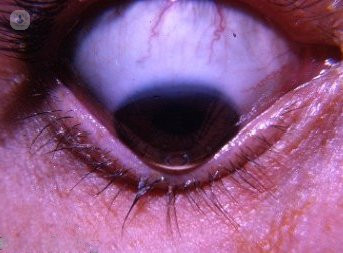


What is keratoconus?
Keratoconus is an eye disorder in which the corneal tissue thins and deforms. The cornea is unable to support the internal eye pressure and it bulges out in a cone shape, hence the name, kerato, which means cornea, and conus, which means cone shaped.
It is a degenerative condition of the cornea that appears progressively in one or both eyes.

Disease prognosis
Although keratoconus is a degenerative disease, it can be corrected with glasses, with contact lenses, and different surgical procedures.
A patient with keratoconus should have regular corneal topographies to detect changes in the cornea.
What are the symptoms?
Keratoconus usually affects young people in the form of myopia and astigmatism as well as blurred vision. It may also cause eye irritation and increased photophobia (light sensitivity). A specialist will confirm the disease when and if they detect corneal thinning in the central or paracentral part of the cornea.
Tests for keratoconus
A corneal topography is done to detect mild forms of the disease, it involves capturing an image of the cornea and creating a topographic map of the eye surface. In cases where the keratoconus is more advanced, a slit lamp exam is done, a keratometer (also known as an ophthalmometer) may also be used, which is a device that is used to measure corneal curvature by focusing a circle of light on it and measuring its reflection.
What causes it?
The exact cause for keratoconus developing is unknown, but it is believed that many cases are due to genetic factors. This disorder is also linked to collagen related diseases, skin conditions, systemic diseases (such as Down’s syndrome), and eye injuries caused by excessive rubbing or by long term use of hard contact lenses.
How can it be prevented?
To prevent keratoconus, it is recommended that you have your eyes checked at least once a year. There are also some actions that are best avoided, such as continuously rubbing your eyes. Early detection is crucial to be able to treat the symptoms and prevent corneal degeneration.
What is the treatment?
There isn’t a cure for keratoconus but there are different treatments available that can slow down its progression, which will depend on how advanced the disease is:
- Glasses or contact lenses
- Semi-rigid lenses
- Crosslinking (CXL): is a minimally invasive procedure in which vitamin A and ultraviolet light are used on the cornea to strengthen bonds and structures of inner collagen fibres. The procedure is performed in an hour on an outpatient basis.
- Ring implants or intracorneal ring segments; implants designed to make the central cornea more homogenous.
- Corneal transplant; although this is only necessary in 10-20% of cases and it involves replacing damaged cornea with a healthy one from a donor.
What specialist should I see?
Keratoconus should be managed by an ophthalmologist.